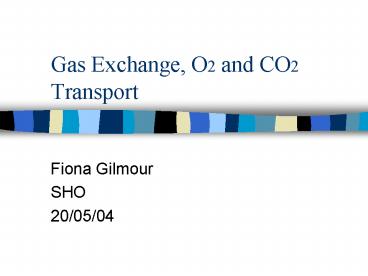Gas Exchange, O2 and CO2 Transport PowerPoint PPT Presentation
1 / 12
Title: Gas Exchange, O2 and CO2 Transport
1
Gas Exchange, O2 and CO2 Transport
- Fiona Gilmour
- SHO
- 20/05/04
2
Gas Exchange
- For adequate gas exchange
- Alveoli must be ventilated
- Capillaries must be perfused
- Gases normally exchanged are CO2 and O2
- Normal O2 consumption 250-300ml/min
- Normal CO2 production 200-250ml/min
- Tidal volume is 500mls, 2/3 used for gas exchange
- 1/3 physiological dead space
3
- Ratio of CO2 produced to O2 consumed is the
respiratory exchange ratio. In steady state this
equals the repiratory quotient RQ 0.82 - R VCO2 / VO2
- Gas consumption or production can be calculated
- VO2 VE (FIO2 FEO2)
- VCO2 VE x FECO2
- O2 extraction coefficient
- VO2 / VI x FIO2 x 100
- At rest this is 15-20
4
Gas Exchange
- Alveolar gas composition determined by
- inspired gas composition
- alveolar ventilation
- Metabolism
- PAO2 PIO2 PACO2 / R
- Mean alveolar PO2 100mmHg
- Mean alveolar PCO2 40mmHg
- PAO2 decreases if PIO2 decreases
- PACO2 decreases in hyperventilation and increases
in hypoventilation
5
Ficks Law of Diffusion
- Gas movement across blood/gas barrier and
blood/tissue barrier occurs by diffusion down
partial pressure gradient - depends on
- Molecular weight and solubility of the gas
- surface area available
- thickness of barrier (distance travelled)
6
Diffusion
- Lung is ideal for diffusion
- Large surface area (50-100 sqm)
- Very thin blood gas barrier (0.3microm)
- Sufficient contact time occurs in alveoli to
permit capillary blood to have same partial
pressure as alveolar gas - CO2 diffuses 20X more rapidly than O2
- Higher solubility but similar molecular weight
7
Oxygen Transport
- 99 total O2 carried in RBC
- 1 in physical solution
- for each mmHg PO2 there is 0.03ml O2/L blood
- normal arterial blood (100mmHg) contains 3mlO2/L
- Amount of O2 per litre of blood depends on
Haemoglobin concentration and degree of
saturation which depends on PO2 - PO2 95mmHg Hb 97 saturated
- PO2 40mmHg Hb 70 saturated
8
Haemoglobin
- Globular protein
- 4 subunits
- Haem group in polypeptide chain
- 4 polypeptide chains globulin
- Each molecule of Hb can bind 4 molecules of O2
- Oxyhaemoglobin is red
- Deoxyhaemoglobin is purple
9
Haemoglobin
- Attachment of 1 O2 facillitates uptake of
subsequent O2 - Haem-haem interaction
- Amount of O2 bound to Hb determined by PO2
- PCO2, pH, 2,3BPG all directly affect globin
molecule and change affinity of haem for O2 and
shifts curve left or right - Bohr effect
10
CO2 Transport
- Deoxygenated blood has high CO2 affinity
- Oxygenation makes globin less able to combine
with CO2 and H - Haldane effect
- results in downwards and upwards shifts in CO2
dissociation curve - Blood contains 2.5 X more CO2 than O2
11
CO2 Transport
- Carried in 3 ways
- Physical solution (5-6 total CO2, 10 in Venous)
- Carbamino compounds (5-10)
- Bicarbonate (85-90)
12
CO2 Transport
- H2OCO2gtH2CO3gtH HCO3-
- slow in plasma but accelerated by carbonic
anhydrase in RBC - RBC membrane impermeable to H so to maintain
electroneutrality Chloride anion moves from
plasma - Chloride shift
- Deoxygenated Hb is less acid so will bind H and
buffer cell

